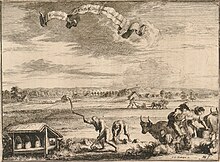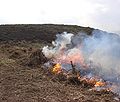Heath farming

The heather farming is a traditional form of agriculture that has been practiced for centuries in the extensive heathland of northern Germany . On the one hand it was the only way to use the nutrient-poor soils of the region productively, but on the other hand it was also the main reason for the spread and further exploitation of the barren heather areas. Heidschnucken and beekeeping formed the basis of the heather farming economy .
The heather farming industry became unprofitable and gradually abandoned in the course of the 19th century. In Wilsede , Lower Saxony , the heather farm economy can still be experienced today. In the small heath village in the middle of the Lüneburg Heath nature reserve , livestock and arable farming are carried out according to historical models.
description

The most important basis of the heather farming economy was the keeping of heather sheep . This undemanding breed of sheep grazed on the heather; Due to the constant browsing of the heather bushes, the heather sheep rejuvenated the heather, which was a prerequisite for good heather bloom. They also ate young tree shoots and thus prevented the heather from being forested. Only the prickly juniper plants were spurned by the animals. The Heidschnucken used both the wool and the meat. The manure was also of particular importance .
The so-called pesting of the heather was characteristic of the heather farming industry . The four centimeter thick topsoil, interspersed with roots, was laboriously plowed, laid out in the barn and then composted together with the droppings of the heather sheep and cattle. The nutrient-rich plague manure from the stables was applied to the small arable land near the farm for fertilization . Rye could then be grown there for several years in a row . When the yield fell, they switched to the more frugal sandy oats and finally to buckwheat . Afterwards, the Dreesch field was left fallow for several years and used as pasture for oxen, for example. A new ten-year cycle then began again with pest fertilization .
The stripped heather areas were renewed relatively quickly through the natural insemination and then served again as Schnucken pasture. More lignified heather was burned to achieve the desired rejuvenation. The heather plants were also used by the farmers as litter for their cattle and, after the lignification, as heating material.
A particularly important factor for the livelihood of the heather farmers was the high-yielding heather beekeeping with the production and supra-local sale of honey and beeswax . In addition to heather sheep and bees, cattle, pigs and horses were also kept.
Rye field near Wilsede using traditional cultivation methods
history


The first settlers settled permanently in the region around 4000 BC. At that time, the landscape consisted of more than 80 percent forest area. Huge, tree-free areas were created around the settlements for animal husbandry and the establishment of arable land, partly as a result of clearing and burning. Calluna vulgaris (common heather ) from the heather family soon settled in these partly swampy areas .
Because of the nutrient-poor soil, the arable land was initially laid out on a very large scale. The barren sandy soil made the cultivation of grain and pasture areas difficult, the arable land was kept usable through fertilization (from cattle farming) on the heather, which, however, further worsened the fertility of the soil. The greater the need for fertilizer, the more cattle were needed, which in turn meant that even more forest areas had to be sacrificed for pastures and the emergence of barren heather areas was encouraged.
Over time, the spreading heather developed into the main work area of the farmers. The maintenance of the huge areas was difficult, a single-digit yard required at least 300 acres of land, of which around 40 acres were rejuvenated annually through tearing, chopping or burning.
More than 1000 years of heather farming meant that the proportion of forest areas in the region had shrunk from over 80 percent to just five percent. From the middle of the 19th century, the barren and barren landscape could no longer feed its inhabitants. Forest pasture for cattle had almost completely disappeared, over 70 percent of the area covered by heather. The heather farming industry was coming to an end from around 1800. In addition to the lack of space and the increasing desertification of the land due to frequent pest, the reasons were the import of high-quality sheep's wool from Australia and New Zealand and the slow replacement of the candle by the kerosene lamp and the honey by the beet sugar. The need for products from the heather decreased.
There was a change for the Lüneburg Heath at the end of the first half of the 19th century through the common division and the replacement of the landlord's burdens. Lands were merged and the farmers became owners of their farms, which improved the situation somewhat. As a result, modernized agriculture and the development of mineral fertilizers led to the heather being increasingly displaced by pasture and arable land.
In 1906, pastor Wilhelm Bode acquired the Totengrund near the Wilseder Berg, a larger heath area in order to preserve it and protect it from building, afforestation or conversion into arable land. This resulted in the Lüneburg Heath nature reserve , which today covers around 23,440 hectares. There are still seven herds of Heidschnucken, which are traditionally kept, but these are too few to ensure regeneration and thus preservation of the heather. It is therefore necessary, for example, to remove young trees by hand (so-called decussing ). In Wilsede and the surrounding area, the typical character of a heath village has been largely preserved. In addition to keeping the heather sheep and caring for the heather areas, traditional heather beekeeping and arable farming in alternating crop rotation based on historical models are also carried out here.
Soil profile in the Lüneburg Heath: Heide podsol with Ortstein
Slash and burn on heathland
literature
- Andreas Koopmann : Agriculture on sandy soils oriented towards nature conservation goals and historical heather farming: Case study of the Tütsberg landscape maintenance farm (Lüneburg Heath). From: Göttingen Soil Science Reports 114 , Institute for Soil Sciences at the University of Göttingen, 2001.
- Rainer Köpsell: Origins of sustainable forestry. An example from the Lüneburg Heath from: Praxis Geographie , October 2012 edition. Available online (subject to a charge)
- Wolfgang Bargmann : The Soltau Settlement in Lower Saxony's History - Volume 1: From the Germanic Settlement to the Thirty Years War , Cupbearer Soltau, 2003, ISBN 3-933802-09-1 .
Web links
- Experience heather farming in Wilsede at natur-erleben.niedersachsen.de
- Günter Miehlich: Soil Human Stories: Poor Soils - Bare Food. From the hard life in the Lüneburg Heath





